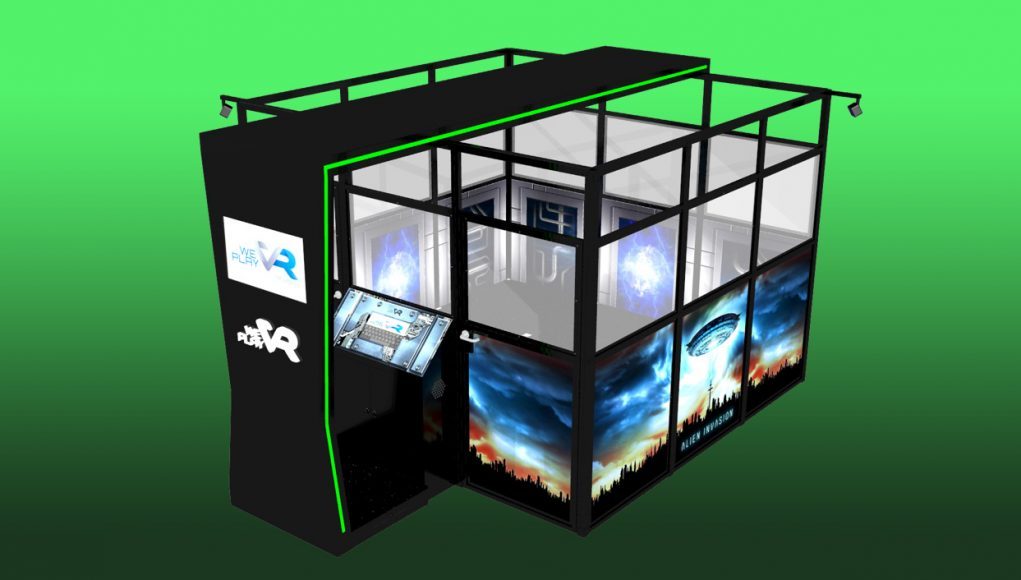AI Solve is creating a modular VR attraction that’s designed as a low-cost pathway for family entertainment centers to bring VR experiences to their customers. With everything in the box, including a VR headset, backpack PC, bespoke experiences, and software that ties it all together, WePlayVR’s modular design affords interesting flexibility that can allow the platform to grow to fit the needs of the venue. I got to step inside one of the WePlayVR pods to experience it for myself.
When it comes to the intersection of VR and out-of-home entertainment, there’s two major approaches: 1) ‘VR Arcades’ where users can pay-to-play the same sort of VR hardware and software that’s available to consumers, and 2) ‘VR Attractions’ where users are offered unique VR experiences not practical in the home. For AI Solve’s part, the company’s WePlayVR pod is focusing on the latter. Yes, the system uses a consumer-available VR headset, but offers up bespoke content that’s built specially for the modular layout of their pod, and adds extras like a haptic floor and unique props to enhance immersion. The WePlayVR system is designed for family entertainment centers which cater their offerings toward kids and teenagers.
Modular and Flexible
What’s especially interesting about the system is its modularity which allows it to scale according to the needs of the venue. The typical square pod is made up of a 6 × 6 grid of haptic floor tiles surrounding by a matching frame. Like Legos, the tiles and walls can connect together in any configuration. For instance, you could opt for a larger square layout, a rectangle, and asymmetrical shape, or even two square areas connected by a thin hallway.
That flexibility offers some interesting advantages—it means that family entertainment centers can start small and test the waters of VR without investing in a huge system, but still retain a direct path to growing the system’s size to fit the venue’s unique demand. The modularity also means that the system’s layout can be rearranged for VR experiences that take unique advantage of a certain layout.
Gameplay
AI Solve is creating their own bespoke content for the WePlayVR system, which means it’s being used for much more than a simple pay-to-play VR arcade. Instead, the company is creating content that matches the WePlayVR pod inch-for-inch, using smart game design tricks—like virtual elevators to ‘move’ players vertically, and virtual moving platforms to ‘move’ players horizontally—to make users forget that they’re even confined within a square room.
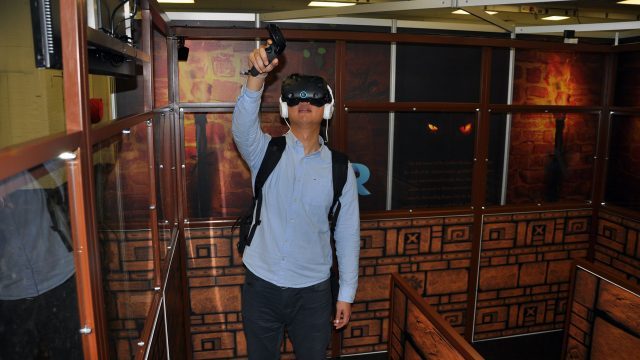
At least, that’s what happened to me. When I donned the Vive headset and MSI VR backpack, I stepped into the pod for a tether-free experience, which is already quite freeing compared to being tethered to a static computer like you would be at home. Playing one of AI Solve’s first titles for WePlayVR, Alien Invasion, I found myself entering into a sci-fi facility of sorts, just in time for an alien attack. Starting behind a desk, a man shouted instructions to me, and I had to move to another room behind the desk and throw a few levers to turn the power back on. On my way back to the desk I was confronted with some spider-like alien creatures and used my zapper-gloves to destroy the critters (by pulling the controller triggers and aiming at the baddies).
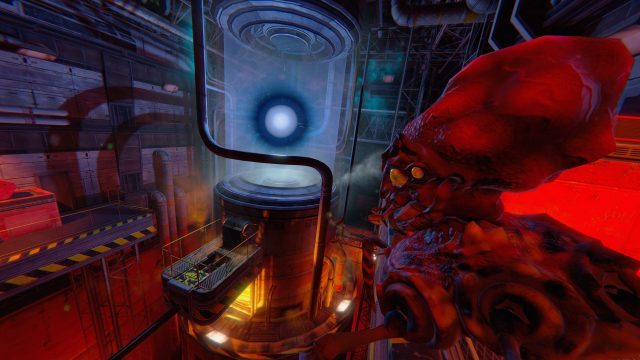
Then I moved into a small elevator which took me down to a lower level; the vibrating floor helped sell the illusion that the elevator was really taking me down to a different room. When the door I opened I had to do a little puzzle involving matching colors before I could take a moving platform across a wide gap (again with the floor vibrating to help sell the illusion) in order to retrieve a power core which would be used later to defeat the aliens once and for all.
Between the elevator, the lift, and the changing environments, I completely forgot where I was within the pod, or even that I was confined to a square space. When I was standing on the moving platform, which, virtually, was open on all sides with a cavernous drop below me, I very well could have actually been in the corner of the pod with walls on either side and I wouldn’t have known. By the time I was ready to take off the headset, I would have been hard pressed to guess where specifically I was standing in the pod, or even which direction I was facing.
Alien Invasion was fun but brief; like AI Solve’s other initial titles for the WePlayVR pod, it’s designed as a five minute experience, which makes sense for the family entertainment center setting, where player throughput is important for profitability (AI Solve expects about 12 players per hour). The games are also clearly targeted toward a family crowd—you’ll be dodging creepy crawlies in a temple, zapping aliens, or solving puzzles rather shooting heads off of zombies or hacking enemies apart with swords, which means less intensity and broader appeal to people outside the hardcore gamer crowd.
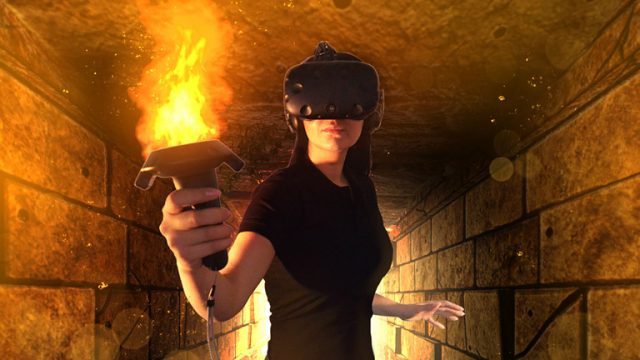
And while Alien Invasion lacked the sort of polish you’d expect from some of the best in-home VR titles, thanks to the lack of tether and the design trickery—which can make the pod feel much larger than it really is—the level of immersion was very high. I also had a chance to play the company’s next game, and while it’s still unfinished, it’s clear to see that with each game project the content is becoming more ambitious and AI Solve is learning how to design around the available space with even more trickery to make players feel like they’re somewhere else entirely than in the confines of the pod. Future games will employ physical props like levers and knobs which will modularly mount into the wall panels, and be integrated into the gameplay for puzzle solving and the like.
Operation & Pricing
When it comes to operating the pod and its components, AI Solve has built a touchscreen control panel directly into the side of the pod. They’ve design a front-end interface which reduces the complexity of the system to a few status indicators (like battery life on the backpack, status of the tracking beacons, and more) and a few buttons for starting and stopping experiences, and restarting the systems if need be. That means operators don’t need to know how to fuss with SteamVR or remotely control the VR backpack PC to get things running, making the WePlayVR pod easy to operate with minimal training.
In terms of pricing, the basic setup—which comes with two VR headsets, backpacks, and controllers, the pod frame and vibrating floor, control computer, and spectator screen—runs $55,000, which also includes one game for the first year, then $1,500 per year for continued use of the game. Additional games cost $5,000–$10,000 for the first year (depending upon the game), then $1,500 yearly after that.
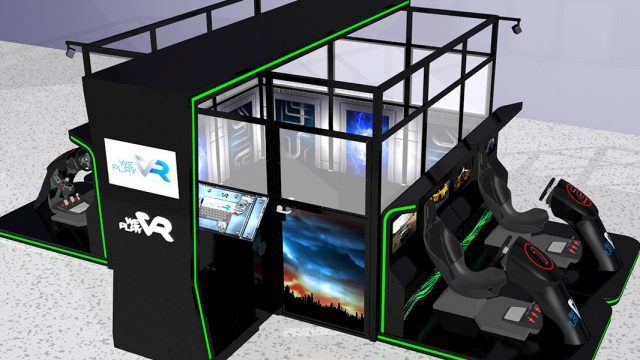
Optionally, the pod can be equipped with four VR racing chairs attached to the sides so that more users can make use of the pod at once. AI Solve told me they’re even considering designing some games for the pod where all four users in the racing chairs and the player in the pod itself would be connected into a single five player multiplayer experience.
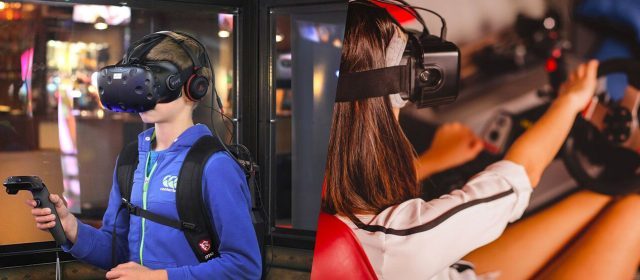
So far the company says the WePlayVR pod is in 16 locations, and rolling out to 40 more in Q1 and Q2. AI Solve expects buyers to break even on the system in six to seven months.

